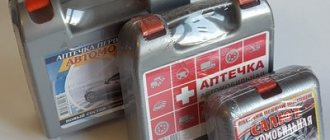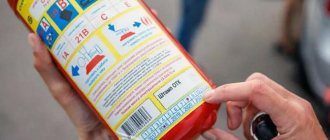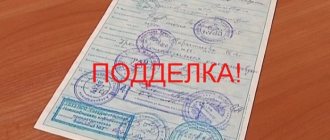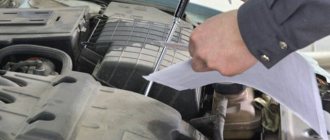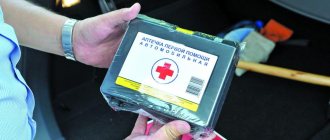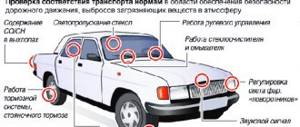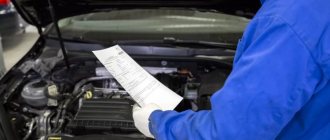In order to present a car fire extinguisher for technical inspection, you need to know the requirements in 2021 well and ensure their implementation. The occurrence of emergency situations associated with a car fire cannot be completely prevented. The driver must be prepared to act in such a situation. To do this, he must have a fully functional fire extinguisher in his car.
Requirements for a fire extinguisher when undergoing maintenance
To successfully pass inspection in 2021, your car fire extinguisher must meet a number of requirements. When inspecting a fire extinguisher, the maintenance station employee pays attention to:
- type of device (in order for a fire extinguisher to be able to put out a fire in a car, it must be designed specifically for this purpose);
- cylinder volume;
- weight (filling level of the container);
- condition of the device (checking the housing, shut-off valves, pressure gauge, etc.);
- best before date.
Two more important requirements for a fire extinguisher during technical inspection in 2021 are compliance with GOST and the presence of markings (date of refueling, address of the enterprise for service).
Find out what else is needed to successfully pass the MOT.
Should there be a fire extinguisher in the car?
Even an experienced driver cannot exclude the possibility of an accidental fire. The car always contains fuel, electrical wiring and flammable materials. If a fire occurs, a fire extinguisher will help put it out. If no measures are taken, a passenger car usually burns out completely in 15-20 minutes.
Its presence in the car is mandatory. For the absence of a fire extinguisher, a traffic police officer can fine you 500 rubles. But the inspector can find out that it is not in the car only during the inspection. It can be carried out only in cases established by law:
- If the inspector has good reason to believe that the car contains items that were used in the commission of offenses.
- There are reasons why it is assumed that explosives, narcotics or other dangerous substances are being carried in a car.
- In the event that an administrative violation has been committed.
In all other cases, the traffic police inspector cannot require the driver to present a fire extinguisher. A fine is not imposed in cases where the driver has used a fire extinguisher to put out a fire and is driving to the place where it is recharged or to buy a new one.
Types of fire extinguishing devices
To understand which type is suitable for a car, we divide fire extinguishers according to the substances inside the cylinder into 4 types:
- Powder (OP). Inside the container there is a powdery mixture made from mineral salts.
- Air foam (AFP). The cylinder contains separate foaming agent and working gas, which form foam at the outlet.
- Gas (OU, VVPA). The extinguishing agent in this case is carbon dioxide or aerosol.
- Liquid or aqueous (OW). Water or other liquid is pumped into the cylinder.
Purpose and design of a fire extinguisher
The purpose of fire extinguishers is to localize fires in their initial stages.
They are one of the primary means of fighting fire and are widely used in various spheres of human life and activity. Structurally, almost all types of devices consist of the following blocks:
- Housing, which can be made of plastic or steel;
- A device that regulates the supply of fire extinguishing agent to the source of fire;
- Tubes with an aerator for gas models, used to loosen the powder and create the necessary pressure inside the cylinder;
- Locking device;
- Spray nozzles (in some models with a hose);
- Safety lock;
- Handles for carrying.
The only device that has fundamental differences in design is the aerosol one. This unit consists of two cavities. Moreover, one of them contains a charge, and the second contains a coolant, which is necessary to extinguish the flame.
In the process of performing this operation, it is possible to obtain a large amount of aerosol, which is used to extinguish the fire.
Car fire extinguishers
To choose a fire extinguisher for a car, consider what can possibly catch fire in it. Often the culprits of ignition are the wiring and fuel system. Extinguishing agents such as water and foam will not extinguish them. Why?
If fuel is on fire, the liquid will not help extinguish the fire due to the chemical resistance of the fuel. By pouring water (foam) onto burning wiring, you will completely ruin it and increase the likelihood of another short circuit.
Even when the cause of ignition is not fuel or wires, the liquid should absolutely not be used, as it will damage the electrician.
Only powder and carbon dioxide devices extinguish a fire in a car.
The powder instantly covers the ignition source and cuts off oxygen. A high-quality powder fire extinguisher extinguishes “everything that burns” - from category A (solid flammable substances) to E (electrical equipment).
There are 2 types of such fire extinguishers:
- With gas already pumped in. When used, such a device immediately produces powder.
- A device inside which a chemical reaction occurs and the desired gas is formed.
The speed of action of the first option is higher.
Carbon dioxide devices release CO2, the temperature of which is minus 70–90°C, under high pressure. Carbon dioxide immediately displaces oxygen, and combustion stops.
When extinguishing a fire using an OU, you should:
- Make sure that the gas does not come into contact with your skin, as this can cause frostbite.
- Do not inhale carbon dioxide.
The efficiency of op amps is higher than that of powder devices.
Choosing a fire extinguisher for technical inspection in 2021
The devices differ in technical parameters - not all models meet safety requirements. Foam and water devices are not suitable for the car due to their small volume and unsuitability for the fuel tank and engine. The car owner needs to have a powder or carbon dioxide fire extinguisher available. The devices have distinctive features.
A carbon dioxide fire extinguisher (CO) contains the active substance CO2. The fire is eliminated by a stream of carbon dioxide, which kills the fire and lowers the temperature. DU is excellent for extinguishing fires in hard-to-reach places. Carbon dioxide fire extinguishers for cars are very effective, but they are more expensive and massive than powder ones.
Powder fire extinguishers (OP) contain a foam composition that blocks the access of oxygen. The devices extinguish fires of any complexity and eliminate secondary fires. The powder fire extinguisher is equipped with a pressure gauge to determine the operating zone. OP is a universal and practical device for extinguishing fires.
Volume Standards
To pass the inspection, your fire extinguisher must have the correct capacity.
In 2021, the volume standard for passenger cars is at least 1 liter, for trucks - at least 2 liters (Decision of the Customs Union Commission dated 12/09/2011 N 877 (as amended on 12/25/18).
Even if the volume matches, the inspector will check the weight of the device during maintenance. This will help determine if the fire extinguisher is 100% full. The permissible weight of the device is 1 kg for each liter of volume.
Powder
The price of powder fire extinguisher is the lowest. That is why this type is the most common today. It consists of a body that contains a special powder and a small amount of carbon dioxide, which is in a compressed state. In the process of pressing the lever of a powder fire extinguisher, the powder under pressure passes through a special cartridge and exits through the nozzle.
It is recommended to use when extinguishing flammable liquids, such as gasoline or diesel fuel. In addition, it perfectly fights ignition resulting from a short circuit. This makes it a universal device that is quite cheap. You will not have any problems passing the technical inspection.
The main disadvantage of a powder fire extinguisher is that its composition causes metal corrosion. Shortly after its use, you need to thoroughly clean the burnt surface from traces of powder, which is also quite problematic.
Has the expiration date expired?
There is an expiration date for a car fire extinguisher, which is checked during inspection. After all, over time, the pressure in the cylinder decreases, and fire extinguishing agents lose their properties.
Real and nominal term
The nominal shelf life is the period provided by the manufacturer when the OU or OP is operational with proper operation.
The actual period is formed taking into account the actual conditions of use and maintenance.
During maintenance, the nominal value is checked, which is indicated on the label or in the fire extinguisher passport.
According to safety standards, the OP is allowed to operate for no more than 10 years. The OU carbon dioxide device has a nominal life of 10–15 years.
Is it possible to extend the expiration date
After the expiration of the standard expiration date, the devices must be disposed of. If the cylinder itself and the fittings are in order, then the fire extinguisher can be recharged and used for personal purposes. But you will have to buy a new one for the car.
Classification of fire extinguishers
Due to the wide variety of fires, there are several classes of fire extinguishers: A, B, C and D. Each class identifies a specific type of fire.
Type A. This option can be used to extinguish various solids. These include all kinds of plastic products found inside the car: upholstery, carpet, etc. This type can easily be replaced with a powder type marked B and C, because it is unrealistic to carry all the fire extinguishing equipment with you
However, it doesn’t matter how many fire extinguishers you carry, since there is no requirement that obliges the driver to have all classes of fire extinguishers. Type B. Excellent for extinguishing all kinds of liquids, such as gasoline, oil, etc.
n. This type of fire extinguisher should be in all cars, because this type of fire is the most common. The price for it is not very high, because it is in constant demand. It's easy to choose. Type C. Designed for extinguishing all kinds of gases used as automobile fuel. The requirements are such that “Type C” is mandatory for passing inspection on vehicles with gas equipment. Make sure in advance that there is a special mount for it, which will allow you to use it as quickly as possible. Type D. This class should be in the case of extinguishing metals and metal-containing substances.
Fire extinguisher storage
Storage rules include not only monitoring the expiration date, but also the location of fire extinguishing agents. There are as many types of cars as there are fire extinguisher mounts. The configuration of the interior space in all cars is different, and therefore it is impossible to say exactly where and how this or that mount should be located. However, to pass inspection, you must have an easily accessible place to store your fire extinguisher. If it lies loose in any part of the cabin, then there is a risk of damaging the trim or even getting injured from a heavy cylinder. Therefore, here are some tips on where and how to place the fire extinguisher:
- Can be secured under the car seat. This type of mount is the most popular, because the fire extinguishing agent is always at hand in an accessible place and allows you to use it quickly.
- You can choose a place for a fire extinguisher in the trunk. Despite the convenience, this is the most unsafe installation method, because it is mainly the front part of the car that catches fire (note that you will have to spend time disconnecting the negative terminal of the battery).
We hope that this article helped you choose the right fire extinguisher that can protect you from any danger associated with a car fire. Remember that the main thing is not passing the technical inspection, but correctly selecting, observing the shelf life of the product, and ergonomically mounting it. Cost should never come first when it comes to safety.
Detailed instructions for use, the exact date of manufacture and expiration date can be found on the body of the fire extinguisher. We wish you good luck on the roads!
Checking the condition of the fire extinguisher
Once a quarter, the correct location of the OP (OU) is checked. Quick access to the device must be ensured, as well as reliable fixation of the fire extinguisher. An inspection point employee checks compliance with safety regulations.
A more thorough inspection is carried out annually. The inspector measures the pressure in the container and also checks the condition of the seal, protective coating, filter, stamp, and pressure gauge. Next, the fire extinguisher is weighed and the degree of contamination of the flexible hose and sprayer is examined.
Fire extinguisher OP 2
When tested by experts, even huge products with the OP-35 index were tested
Samples from 12 different manufacturers filled with carbon dioxide were also not ignored. However, in most cases, 2-liter fire extinguishers of the OP-2 brand are more suitable for a motorist.
Why two-liter products and why only powder ones? Yes, because various recommendations advise using two-liter fire extinguishers in cars. And powder ones - due to their cheapness and prevalence.
It is correct in this situation to talk about two-kilogram, and not two-liter fire extinguishers. But among Russian car enthusiasts, it was the term two-liter “red cylinders” that took root. Therefore, we will continue to call them that way.
For a cheap ear, as people say, you have to pay. Therefore, a huge disadvantage of powder fire extinguishers is their ability to pollute the fire. If you decide to use such a device to extinguish a flaming engine, you will need to buy a new one. In this case, the powder sticks to the surface in a dead layer, making it impossible to remove it.
The fire extinguisher should be stored in an easily accessible place
However, its carbon dioxide “brother” will hardly harm your engine, but it has another drawback. If you take the bell, you will definitely get frostbite on your palm, it is very cold.
So, in this publication we are talking only about OP-2. And there was a whole football team of such models. And, what is most interesting, out of the eleven “players” only five were playing, the rest all did not get up from the bench. The match results can be analyzed from the table.
Fire extinguisher test results - click on the picture to enlarge
Note. The designation “n/a” indicates that the experts were referring to past test data.
Recharging the device
The powder device requires mandatory recharging once every 5 years, the carbon dioxide cylinder is recharged at the same interval. In the case of OP, it is more profitable to buy a new fire extinguisher, since the cost of recharging and purchasing is almost the same.
New carbon dioxide devices are more expensive, so recharging the op amp is more feasible.
To recharge the fire extinguisher, the car owner comes to the service station, where:
- OU (OP) is inspected.
- They check and test.
- When the employee is convinced that the fire extinguisher can be recharged, new powder (gas) is pumped into the cylinder.
Tell A
Yes, it's a sad situation. Some devices, according to the commission's conclusion, are generally dangerous. By refusing to work at a time when it is so necessary, they can cause a lot of harm.
In some cases, a car fire extinguisher will not work because instead of good powder, sand was poured from a children's sandbox. In others there is no pressure at all. Thirdly, threaded connections are etched. And in the fourth case, gas was added, the volume of which was insufficient for good extinguishing.
However, the main problem of all manufacturers is unusable powder. Manufacturers know very well where they can save money. The most “honest” ones accidentally do not add the name of the powder on the labels.
Testing a fire extinguisher in open areas
The cunning ones write everything correctly, but brazenly pour cheap surrogate into the cylinders. But the difference between them is fivefold.
ABCE powder is based on ammonium phosphate, while VSE is based on cheap sodium bicarbonate. Therefore, some manufacturers first reduce the quantitative component of phosphates, and after that, instead of ALL, they designate ABCE on the labels. It happens that another saving occurs - instead of 2 kg of powder, 1.6 kg is added.
Types of fire extinguishers and their service life:
Service life of powder fire extinguishers (OP)
Depending on the powder used in the fire extinguishing agent, which is used as a fire extinguishing agent, its service life is determined. There are three types of powder fire extinguishers:
- Downloads . Their work is that an inert gas pushes out the powder under a certain pressure. Mainly nitrogen and carbon dioxide are used, less often air.
- Gas generators . The cylinders are filled with powder, and a special gas capsule distributes the pressure.
- Self-acting . The devices are filled in advance with powder and gaseous substances so that, under the influence of high temperatures, they begin to operate independently and extinguish the source of fire.
Pressure checks should be performed at least once a quarter. In this case, the result is noted in the fire-fighting equipment registration log. A major inspection and certification is carried out every five years. Powder fire extinguishers, regardless of type, are subject to mandatory testing for the quality of the substance contained inside. From the entire batch, in the amount of 3% of its volume, prototypes are taken. For example, if an institution has 100 fire extinguishers, then any three are subject to inspection.
The shelf life of OP directly depends on the quality and labeling of the powder used:
- PSB-3M . It can be stored for no more than 4 years and is suitable for eliminating fires of fire hazard class B and C.
- Wexon-ABC . Shelf life – 5 years. Suitable for extinguishing class A, B or C fires.
- Foscon . Can be stored for no more than 10 years and is used to prevent fires of fire hazard classes A, B, C and E.
Powder fire extinguishers intended for transportation in vehicles are recharged once every 3 years and serve, according to standards, no more than 10 years. Although they may remain serviceable for a long time, it is not recommended to use such cylinders in order to prevent the spread of fire.
Service life of carbon dioxide fire extinguishers (CO)
According to the standard, stable pressure must always be present inside the cylinder of carbon dioxide fire extinguishers. This is due to the fact that carbon dioxide is pumped there in a liquefied state. For these purposes, there are a number of requirements that must be observed in enterprises and workshops:
- checking devices for pressure, taking into account a small deviation from the norm (up to 5%), at least once a quarter;
- annual technical condition inspection;
- mandatory recharging of the cylinder once every five years (it does not matter whether the pressure remains inside or not).
The OS can last up to 15 years. Regardless of this period, it is recharged every 5 years. The procedure is carried out by weighing the fire extinguisher and comparing the displayed values with the data entered in the passport. Recharging must be carried out when the value deviates by more than 5%. If after 15 years the pressure remains normal, then the device, despite this circumstance, is taken out of service and replaced with a new one.
Carbon dioxide fire extinguishers used in cars are recharged every 5 years and can be used for up to 20 years in a row.
Service life of emulsion fire extinguishers (EFE)
Expensive fire extinguishers with high operating efficiency. For comparison, we can say that 5 - 7 liters of ORP is equal to 100 liters of ORP. Air emulsion cylinders with a fluorine-containing charge do not need to be recharged. Service life – 10 years . During this time, the EIA does not require a technical inspection.
In most cases, recharging the OVE is quite problematic. Moreover, this procedure is not cheap. Therefore, such fire extinguishers are considered disposable. After 10 years they must be replaced with new ones. The maximum service life is observed at temperatures from -40°C to +50°C.
Shelf life of refrigerant fire extinguishers (OH)
Freon fire extinguishers are a type of gas primary fire extinguishing agent. Their shelf life is the same as that of OU. The exception is some freons, which have an increased corrosive effect. In relation to them, the fire extinguisher label indicates its expiration date.
The charge efficiency duration is more than 5 years. But for safety reasons, gas, regardless of the established period, is renewed after the expiration of the period indicated on the label.
Service life of foam fire extinguishers (ORP and OHP)
The expiration of the prescribed shelf life of foam units occurs, as a rule, due to the occurrence of serious corrosion formations at the joints and on the body of the fire extinguisher. Metal oxidation occurs under the influence of water and foam. Checking of redox potential and chemical hazards is carried out once a quarter without fail, with entry into the fire extinguisher logbook.
In relation to foam fire extinguishers, the following actions are carried out:
- Testing for corrosion processes. If during the inspection areas with rust are identified, then such a unit is sent for repair and recharging.
- Replace with a new ORP or OCP once a year. Even if during the year the fire-fighting equipment has retained its original condition and no traces of corrosion are found on its body, it is nevertheless subject to write-off.
Foam devices cannot be recharged, since the internal planes of the cylinder are immediately corroded by moisture and cannot be restored. The shelf life of ORP and OCP is unchanged and is exactly one year from the date of commissioning.
For water fire extinguishers (WF)
Water fire extinguishers are the most vulnerable to corrosion processes inside and outside the housing. Their service life and maintenance are exactly the same as those of ORP and OCP ( 1 year ). But in fact, they fail much more often than expected, since water strongly corrodes the metal and makes them unusable.
For aerosol (GOA or AGS)
The service life of fire extinguishers marked GOA or AGS is exactly 5 years for conventional models used in residential and non-residential premises, and 2 years for automobile models. Disposable GOA or AGS are often purchased. Their service life ends after the first fire extinguishing.
Is it possible to use an expired fire extinguisher?
Due to safety precautions, an expired fire extinguisher of any type must not be used. Automotive fire extinguishing devices with expired service life may cause the vehicle to fail a technical inspection. The use of expired fire extinguishers is potentially dangerous due to the following circumstances that may arise when it is necessary to extinguish a fire:
- failure and impossibility of its operation;
- change in effectiveness due to loss of fire extinguishing agent properties.
Expired fire extinguishers can be used as a training tool. Such cylinders are used for training in fire classes and at enterprises when studying safety precautions and practicing fire extinguishing skills.
Fire safety standards prohibit the presence within the walls of an enterprise or institution of any type of fire extinguisher that has expired and has not passed mandatory inspection.
Required number of fire extinguishers
The vehicles used differ in their dimensions and the number of cylinders in the cabin. We discussed whether a fire extinguisher is needed for technical inspection a little higher. Let's talk about the numerical indicator in more detail.
In a car
The devices used in small-sized machines are:
- Carbon dioxide.
- Powder.
For a car weighing up to 2 tons, one cylinder is enough. The main component is the mass of the material pumped inside.
In the truck
Large vehicles used for transporting goods are equipped with two devices of the OP-5 type. The 2018 traffic regulations require mounting one cylinder near the chassis, and the second in the area of the tanker (truck).
In the bus
Vehicles carrying people are equipped with three fire extinguishers. One is installed in the cabin, the other two are mounted in the cabin. They are protected from possible damage. A mandatory requirement is accessibility.
Disposal of an old fire extinguisher
There are no specific rules regarding the disposal of an old fire extinguisher, so we will consider the most popular options for using an unusable fire extinguisher:
- Refill. Despite the expiration date of the fire extinguisher, often the cylinder itself is still in good condition (if it was handled correctly). Therefore, a refilled old cylinder can be taken to the dacha or placed on the balcony in case of fire, what if it comes in handy? However, this fire extinguisher can no longer be used in transport.
- Take all fire extinguishers to a recycling center.
- Conduct a short training session to gain experience using a fire extinguisher.
So, for a driver, having a car fire extinguisher is vital . No matter how experienced he is, there is always a risk of the car catching fire due to a breakdown, so the presence of this device will save the lives of both the driver and passengers.
Sources
- https://ProffiDom.ru/159-ognetushitel-avtomobilnyj.html
- https://PozharaNet.com/ognetushiteli/jekspluatacija/sroki-godnosti-avtomobilnyh-ognetushitelej-chto-dolzhen-znat-voditel.html
- https://stavto.ru/articles/poryadok-opredeleniya-sroka-godnosti-ognetushiteley/
- https://ohranatryda.ru/tehnika-bezopasnosti/periodicnost-proverki-ognetusitelej.html
- https://zaschita-prav.com/srok-godnosti-avtomobilnogo-ognetushitelya/
- https://zen.yandex.ru/media/yavmashine/ognetushitel-avtomobilnyi-dlia-tehosmotra-2019-godu-trebovaniia-5cc20f75c53c2900afb2bf97
- https://keysafety.ru/net-pozharu/ognetushiteli/avtomobilnyj-ognetushitel.html
What fire extinguisher should be in a car and requirements in 2021
- If a fire is detected, it is necessary, first of all, to evacuate, and if there are passengers in the cabin, help them get out too. Take out a fire extinguisher, pull out the pin, first breaking the seal.
- Point the nozzle directly at the fire and press the lever.
- You need to approach the fire from such a direction that the wind blows at your back and not in your face.
- It is necessary to start extinguishing the flame from its base.
- It is most effective to extinguish the fire not with one fire extinguisher, but with several, using the help of another group of people.
- Before you finish extinguishing the fire and put the device aside, make sure that there is no re-ignition.
- After the cylinder has been used, submit it for a specialized inspection
The most important thing in our life is health. A fire extinguisher is an essential item in any car. Don't skimp on buying it. Your life and the lives of your passengers are much more valuable than a few thousand rubles. On the Internet you can find many cases where people died in a car that caught fire. This happened due to the banal absence of a fire extinguishing device in the cabin. Speaking of safety, we note that during storage many people make mistakes by placing the cylinder in the luggage compartment. There it is churned and poses a danger. It should be located near the driver's seat to ensure a quick response to a danger.
To summarize, we can note the fact that the price is not as important as the type (we discussed the characteristics of each above). And don’t overpay for the manufacturer’s brand; base your choice on those models that have been tested and proven their reliability and quality. Cheap doesn't mean bad.
We wish you never have to use a fire extinguisher!
A car is a device with an increased fire hazard. This is due to the presence of electrical devices, live cords, mechanical components in conjunction with the fuel system, as well as other materials such as grease, oil and interior trim that can quickly ignite. The same applies to vehicles that run on gas and are equipped with all kinds of electronic devices such as anti-theft devices. Not all automotive equipment is installed according to technical standards. A fire extinguisher in a car is nothing new. These are not only regulatory requirements. Every motorist must agree to its presence for his own safety.
The main purpose of a car fire extinguisher is to localize sources and prevent its spread during a fire.
Kinds:
- Powder. In an emergency, powder thrown onto a fire under pressure for 6 seconds can contain it. Disadvantages include heavy contamination in the form of white residues, as well as the inability to eliminate a strong source of fire.
- Carbon dioxide. The snow-like substance falls onto the flame and extinguishes it. Able to penetrate hard-to-reach places. Leaves no traces. This substance is used to treat live vehicle components. The disadvantages include increased gas formation, which can be harmful to health.
Important! If such a mass gets on the skin at low temperatures, it can lead to frostbite.
- Air-acid. Less effective compared to the previous ones. Packaged in small aerosol cans, which are convenient to store in the cabin.
If you choose a fire extinguisher by class, you need to consider what materials it will be used for, namely: for extinguishing liquids, rubber materials, solid metal objects, as well as when operating electrical equipment. You can buy devices of different classes, but it will be expensive for the user, as it will take up a lot of space in the trunk. And in an emergency, there won’t be time to figure out which item to use and which canister to use. Universal models are capable of extinguishing fire on any surface, but are expensive and have a weak effect.
Choosing a manufacturer
The domestic market of automobile fire extinguishers includes both Russian and foreign manufacturers. Most of them comply with GOST R 51057-2001 standards. Let's look at some of them.
Video about making fire extinguishers:
https://youtube.com/watch?v=ujtCPKvPr-4
Russian manufacturers
- JSC "Rusintek" The Moscow company has been operating on the market for 5 years. Its main activity is the development and production of fire safety products, which include automobile fire extinguishers. A wide range of hand-held devices can be purchased in volumes from two to 50 liters.
- NPK "Fire Safety Systems and Technologies", St. Petersburg. The research and production company has been operating for 13 years and specializes in the production of fire safety equipment. Quality certificates allow this manufacturer to be among the leaders whose products are recommended for use in cars.
- Nota Bene from St. Petersburg. The company is represented on the market with a compact aerosol fire extinguisher OX-1, which has successfully passed acceptance tests. This device has good performance, as well as high efficiency at a low price. A universal fire extinguishing agent designed to extinguish various types of fires.
- Group, Yaroslavl. The leading Russian company offers primary fire extinguishing agents; among other things, you can purchase portable carbon dioxide (OU-1,2,3,5) and powder (OP-2,3,4,58).
- PA "Pozhtekhavtomatika", Moscow. One of the oldest largest companies on the domestic market (operating since 1997) offers a large selection of fire fighting equipment.
- LLC "Onyx" (Tatarstan). The Zelenodolsk company today presents a wide selection of high-quality automobile fire extinguishers on the market.
Among others, we should remember about (Moscow), “Graphite” (Nizhny Novgorod), “Pikhta” (Orenburg), “PAIS” (Kirov), “Ogneborets” (Ekaterinburg), “Movekom” (Izhevsk), “Security Systems” ( Saratov), “Siberian Arsenal” (Novosibirsk), “Tana” (Rostov-on-Don) and others.
Video shows tests of Russian-made fire extinguishers:
CIS countries
Among this type of product for cars on the markets you can find devices produced in Belarus and Kazakhstan.
- Fire Safety Support M (Almaty). The Kazakh company, specializing in the production of fire safety products, has long established itself in Russia. Their motto is the latest technology along with low prices and safety.
- Aegis (Almaty, Kazakhstan). The group provides a wide range of relevant services in the field of fire extinguishing. In the price list you can find various types of extinguishing devices, including powder and carbon dioxide.
- “Pozhtekhnika” (Vitebsk, Belarus). The Belarusian manufacturer offers users various types and types of fire extinguishing devices that comply with ISO 9001 quality standards.
Far abroad
Fire extinguishers for cars made in Italy, Turkey, China and other foreign countries. Some of them have proven themselves on the positive side (for example, the Italian company SVM), while other devices did not cope with the task during testing (Turkish).
Varieties
The same Code of Rules states that one of three types can be used in cars: powder, water or gas (carbon dioxide). Let us immediately note that the water version does not work at sub-zero temperatures. The water or aqueous solution simply freezes inside the case. And such a car fire extinguisher will be of no use, its suitability is zero. Therefore, we are left with powder labeled “OP” or carbon dioxide “OU”.
Of these two, experts distinguish the powder model. Firstly, it is not inferior to carbon dioxide in its fire extinguishing characteristics. Secondly, it is cheaper. Thirdly, it is lighter, therefore more convenient to use.
As for the brand, OP-2 and OU-2 are used in passenger cars. If possible, it is recommended to purchase models OP-3 or OU-3. They are more expensive, the same height as previous brands, only slightly larger in diameter and heavier in weight. But they have 30% more extinguishing agent, which is an important factor in extreme situations.
One point regarding OP-2. Its design includes a very small bell. This sometimes becomes the reason for the young inspector’s refusal to accept the car, that is, a situation arises when the car fails to pass a technical inspection. The owner of the car and OP-2 should know that there is a socket in the device. It just looks like a plastic cap.
Powder injection fire extinguisher for automobiles
If the main thing for you is to pass the technical inspection, then OP-2 is suitable in this situation. If you want to have a good quality fire extinguisher inside your car, then it is better to purchase an OU-2 or a higher quality powder device.
How they work
Since each type has a different type of fire extinguishing agent pumped into it, their extinguishing principle is different.
Carbon dioxide
Carbon dioxide is pumped inside the cylinder. This is a gas that leaves the bell at a low temperature, which helps reduce the temperature in the combustion zone. Plus, it covers the same area, preventing oxygen from penetrating into it.
If we talk about the advantages of op-amps, we note:
- gas penetrates into the most inaccessible places;
- does not leave marks on the car;
- during long-term storage does not change its technical characteristics, qualities and properties;
- The gas itself is a good dielectric.
As for the disadvantages, this is just one point - when used, a cloud is formed, which can cause poisoning if the concentration of the fire extinguishing agent is high.
Carbon dioxide fire extinguisher for automobiles
Powder
The operating principle of this type is based on the transformation of a powdery substance into foam when it comes into contact with hot surfaces and combustion products. The big and main advantage of the OP is the ability to use it to extinguish fires of varying degrees of combustion. Regarding the disadvantages, this is the formation of a fairly durable layer, which is difficult to remove from the surfaces of the car after a fire.
Depending on the state of the fire extinguishing agent inside the cylinder, fire extinguishing agents are divided into three groups. Each of them is designated by a specific letter, which is added to the brand of the device.
- Letter "Z". These are the so-called injection units. The powder is simply pumped into a cylinder under pressure, which ensures its delivery speed when using OP.
- “B” means that inside the cylinder, in addition to the powder, there is compressed air. When you press the handle, the balloon is punctured. The air rushes out through the nozzle, carrying the powder with it.
- The letter “G” means that inside the cylinder there is a so-called gas-generating cartridge. The latter contains special substances that form pressure when in contact with air. When pressing with your hand on the handle, the cartridge is pierced with a special spike. This is how the substance inside is mixed with the air inside the cylinder.
Powder with gas-generating cartridge
Types of fire extinguisher inspections
The procedure begins from the moment of purchase and installation of the device at the place of its permanent storage.
Frequency of recharging fire extinguishers: application, acts
Maintenance of fire extinguishers consists of a thorough visual inspection of the device. Simply put, this is a comparison of the data indicated on its label with the information in the passport:
- complete set;
- no external damage or scratches;
- The locking and trigger mechanism is sealed, the information there is written legibly.
Then control weighing is performed. Any sensitive scale will do. If the real weight of the device coincides with the written characteristics, everything is fine.
All data received plus the date of the initial examination must be entered in the journal. The procedure is carried out by a responsible person appointed in advance by the manager.
Fire extinguisher maintenance has its own frequency:
- quarterly inspections;
- annual inspection.
Moreover, in addition to the device itself, it is necessary to study its storage environment, to what extent it meets the stated requirements. If the environment is close to unfavorable, this will affect the overall service life.
After installing new protective equipment, it is worth conducting an introductory session, involving the team. Show people the devices, perhaps perform an initial inspection together, at the same time telling them how to use them
.
Rules for operating the OP
Quarterly
In meaning and order of action, it is similar to the primary one. The procedure is mandatory; this is done by the person responsible for fire safety measures. He needs to study the documents, visually inspect each device and make an appropriate entry in the journal. If deficiencies are identified, call a technician to make repairs.
Types of actions:
- inspection of the appearance of devices;
- studying documentation;
- examination of the integrity of the filling.
The head of the organization can prescribe unscheduled procedures if circumstances so require. For example, the device was dropped, it “survived” flooding, a short circuit occurred in the place where it was stored, etc.
Annual
Every year it is advisable to invite a specialist who can carry out a professional examination - connect fire extinguishers to special devices in order to identify:
- the amount of substance inside;
- presence of leaks and other malfunctions.
This is done by a professional from a licensed organization. This cannot be detected by eye or by shaking the container.
Full check
Happens every 5 years. This is the most thorough and complete of all procedures, during which:
- Accompanying documents are being studied. They look at how fire extinguishers were checked in general, how often and by whom. How accurate are the written records?
- The specialist discharges all devices, removing the fire extinguishing agent. Then he inspects the fire extinguisher from the inside, examining the integrity of the shell. The functionality of the trigger mechanism is checked by doing practical tests.
- All detected violations, even minor ones, are eliminated. The specialist evaluates the scale of the work itself. If repair is possible, the devices are repaired; if not, it is advised to destroy the faulty device and replace it with a new one.
Re-examination is periodic. Old devices are being updated.
The duration of the procedure is the same and does not depend on the type of device and its additional properties. Thus, the inspection frequency for powder fire extinguishers is identical to other types.
Internal structure of a fire extinguisher
Why is it necessary to have a fire extinguisher in a car?
The driver’s obligation to have a fire extinguisher in the car is stated in Federal Law No. 170-FZ of July 1, 2011 “On Technical Inspection of Vehicles,” as well as in Resolution No. 1008 of December 5, 2011 “On the procedure for undergoing maintenance.” Passenger cars must be equipped with a fire extinguishing agent with a volume of at least 2 liters; trucks and buses are equipped with one device in the cab, and a second in the cabin or body. These conditions are caused by the high likelihood of vehicle fires igniting. Common causes of car fires include:
- Electrical short circuit;
- Leaks in the fuel system;
- Intentional arson.
Fire extinguishers remain the most popular fire extinguishing means and often, even before the arrival of the Ministry of Emergency Situations, it is possible to eliminate the source of fire with their help. They are placed in accordance with the standards of GOST 12.4.009 “Fire fighting equipment for the protection of objects” outside the area of direct sunlight, in plain sight and in easy accessibility. A suitable place in the car is near the driver's door.
